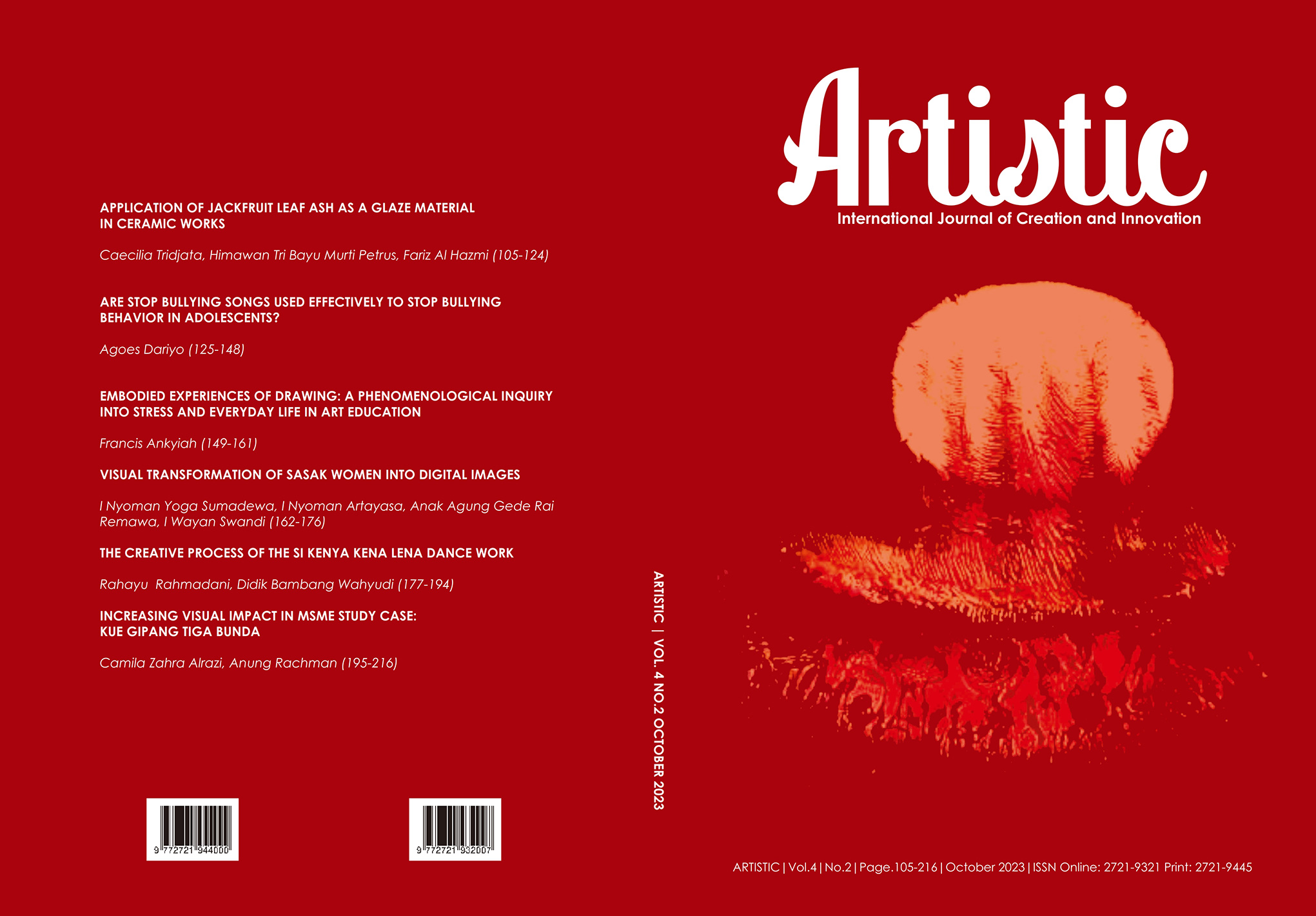THE CREATIVE PROCESS OF THE SI KENYA KENA LENA DANCE WORK
Keywords:
creation, choreography, youth, Sandur, East JavaAbstract
Teenage problems and traditional arts are attracting themes of the creation of dance works. This creative research explores the issue of dance compositions, specifically focusing on the process involved in developing the dance work Si Kenya Kena Lena. The dance work incorporates a synthesis of notions derived from Alma Hawkins and Sumandyo Hadi. The implementation of this theory was conducted in four distinct steps, specifically preparation, organization, arrangement, and presentation. The process of creating a dance piece involves five distinct stages: sensing, valuing, envisioning, embodying, and shaping. This artistic research generates innovative dance pieces that effectively showcase the emotional upheaval experienced by teenagers in their quest for self-discovery, skillfully incorporating Sandur traditional art and East Javanese dances. The use of traditional art aspects in the creative process can generate choreography that imparts a fresh and nuanced perspective.
Downloads
References
Hadi, S. (2003). Aspek Aspek Dasar Koreografi Kelompok. Lembaga Kajian Pendidikan dan Humaniora Indonesia.
Hawkins, A. M. (1981). Interview of Alma Hawkins. https://static.library.ucla.edu/oralhistory/pdf/masters/21198-zz0008zcgr-5-master.pdf
Hawkins, A. M. (1990). Creating Through Dance [Mencipta Lewat Tari] trans. by Sumandyo Hadi). ISI Yogyakarta.
Hawkins, A. M. (2003). Moving From Whitin: A New Method of Dance Making [Bergerak Menurut Kata Hati : Metoda Baru Dalam Menciptakan Tari]. Masyarakat Seni Pertunjukan Indonesia (MSPI).
Indrayuda. (2015). Continuity of Tradition Dance: Acedemicians’ Intervention on Artists and Performing Arts Groups. HARMONIA : Journal of Arts Research and Education, 15(2), 138–143. https://doi.org/10.15294/harmonia.v15i2.4454
Langer, S. K. (1986). Problem of Arts (Problematika Seni) translated by F.X Widaryanto. STSI Bandung.
Moleong, L. J. (2018). Metode Penelitian Kualitatif. PT. Remaja Rosdakarya.
Padmodarmaya, P. (1998). Tata dan Teknik Pentas. Penerbit Balai Pustaka.
Peterson, A. R. (1980). The Anthropology of Dance [Antropologi Tari] translated by FX. Widaryanto. Sunan Ambu Press STSI Bandung.
Rustiyanti, S., & Listiani, W. (2017). Visualisasi Tando Tabalah Penari Tunggal dalam Photomotion Pertunjukan Rampak Kelompok Tari Minang. MUDRA Jurnal Seni Budaya, 32(2), 220–228.
Siswayanti, N. (2013). Nilai-Nilai Etika Budaya Jawa dalam Tafsir Al-Huda. Jurnal Analisa, 20(2), 207–220.
Sosodoro, B. (2014). Klasifikasi Karakter Rebaban Gaya Surakarta. Keteg, 4(1), 14–26.
Widyastutieningrum, S. R., & Wahyudiarto, D. (2018). Pengantar Koreografi. ISI Press.
Yulianti, N. P. S. (2022). Creative Process of Halang Dance. ARTISTIC : International Journal of Creation and Innovation, 3(1), 46–64. https://doi.org/10.33153/artistic.v3i1.4431
Downloads
Published
How to Cite
Issue
Section
License
Copyright (c) 2024 Rahayu Rahmadani, Didik Bambang Wahyudi

This work is licensed under a Creative Commons Attribution-NonCommercial-ShareAlike 4.0 International License.
Copyright
Authors who publish with Artistic agree to the following terms:
- Authors retain copyright and grant the journal right of first publication with the work simultaneously licensed under a Creative Commons Attribution License (CC BY-SA 4.0) that allows others to share the work with an acknowledgment of the work's authorship and initial publication in this journal.
- Authors are able to enter into separate, additional contractual arrangements for the non-exclusive distribution of the journal's published version of the work (e.g., post it to an institutional repository or publish it in a book), with an acknowledgment of its initial publication in this journal.
This work is licensed under a Creative Commons Attribution-ShareAlike 4.0


